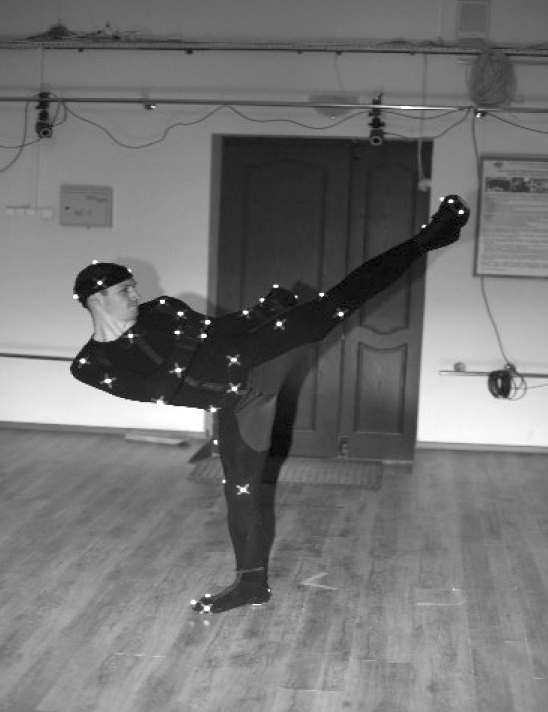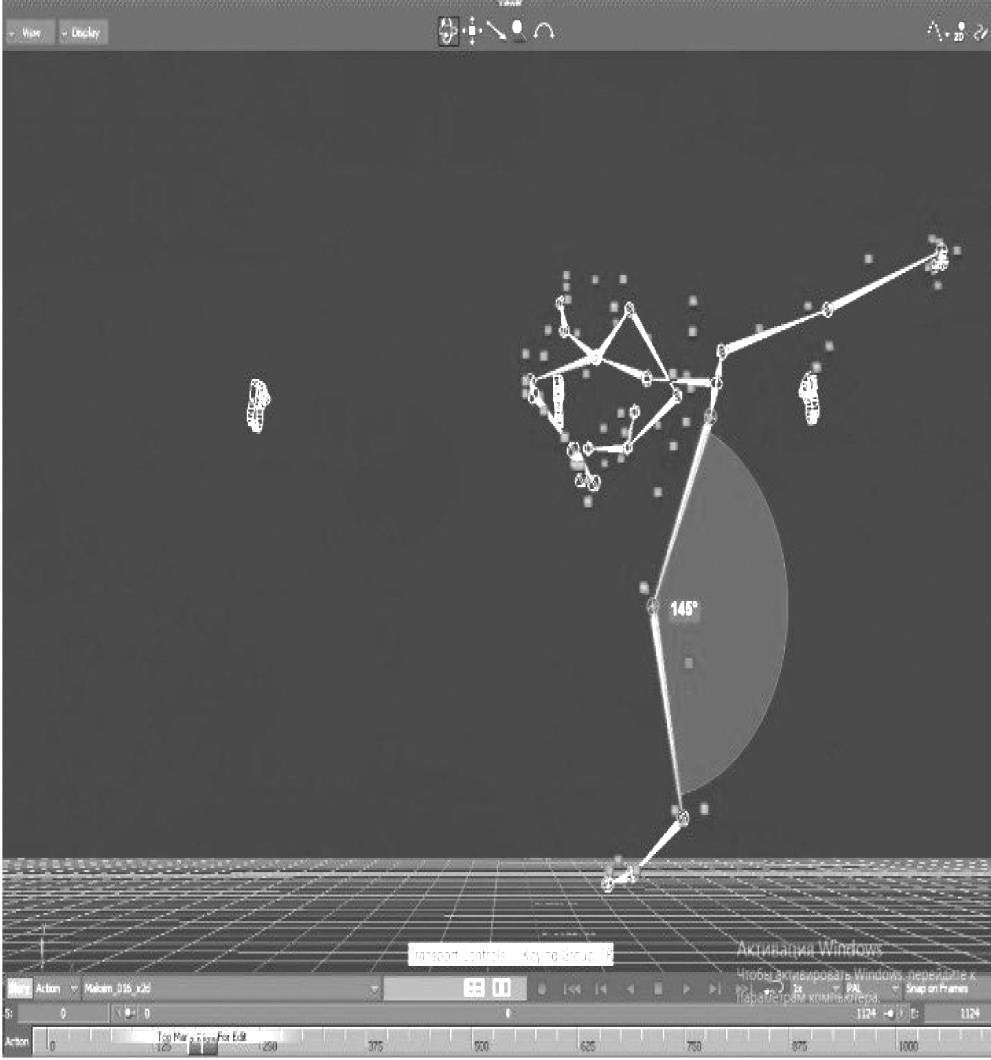Aerial 540° reverse hook kick in taekwondo: timing aspect
Фотографии:
ˑ:
PhD, Associate Professor V.V. Volskiy1
PhD M.A. Rogozhnikov1
PhD, Professor K.N. Dementiev1
1St. Petersburg State University of Architecture and Civil Engineering, St. Petersburg
Keywords: taekwondo, complex coordinated moves, aerial phase, aerial 540° reverse hook kick.
Background. Taekwondo, a new Olympic sport discipline, is increasingly popular the world over nowadays. The sport has been further promoted and received a boost from a few new taekwondo sub-disciplines including TK-5 Kerugy (competitive bout) program and taekwondo freestyle Poomsae (formal routines) [4]. Success in taekwondo bouts is normally determined by individual mastery in complex coordinated moves. A successful spinning hook kick in head is worth 4 points, and a few kicks may be decisive for success. This is the reason why elite athletes give a growing priority to highly-scoring complex coordinated techniques in the training systems [2, 6].
Competitors in the Poomsae sub-discipline perform freestyle routines to the music, with each routine including obligatory elements of the modern competitive taekwondo plus acrobatic elements with leg kicks. The freestyle routines must include complex coordinated taekwondo moves rated by the referees with account of the difficulty levels depending on the following: leg kick and jump heights in the sideward leg kick exercises; numbers of the aerial straight leg kicks; body rotation angles (360° to 540°; 540° to 720°; and 720° plus) in the aerial leg kicking moves; five successive kicks in the relevant sparring combinations; and quality of acrobatic elements with kicks.
Objective of the study was to analyse the 540° reverse hook kick in taekwondo; with a special emphasis on the phase-specific timing rates of the kicking sequence; and calculate the average phase-specific timing rates of the 540° reverse hook kick.
Methods and structure of the study. The 540° reverse hook kick was subject to a biomechanical analysis performed at Saint Petersburg State University of Architecture and Civil Engineering (SPSUACE). Subject to tests under the study were 10 elite taekwondo competitors (qualified by WTF) from the Saint Petersburg picked freestyle taekwondo team, including one World Class Master of Sport, three Masters of Sport and six Candidate Masters of Sport. In the test process, each master (dressed in a special test outfit) was required to execute a 540° reverse hook kick, with the movement sequence captured by ten infrared video cameras and processed by Motion Capture software to produce 3D-models profiling each athlete’s technique: see Figures 1 and 2.

Figure 1

Figure 2
The individual technique capturing 3D-models were analysed in every movement phase to profile the 540° reverse hook kick and offer an ideal kick execution model. We applied Motion Builder 2013 software toolkit to rate timing of each phase in the kicking sequence, with the outcome data processed by STATGRAPHICS tool to compute the averages.
Study results and discussion. The study data and analyses made it possible to profile each phase of the movement sequence. The aerial phase was tested to include a tuck phase required to keep the body rotation rate high enough for success of the leg kick. Given in Table 1 hereunder are the phase-specific averaged timing rates for the 540° reverse hook kick.
Table 1. Averaged phase-specific timing rates for the 540° reverse hook kick
|
Kick phases with variables |
Values |
Average |
|
|
min |
max |
||
|
Total time of the kick, s |
2,583 |
2,763 |
2,659±0,02 |
|
Takeoff phase time, s |
0,833 |
1,000 |
0,87±0,01 |
|
Tuck phase time, s |
0,097 |
0,138 |
0,113±0,004 |
|
Charge phase time, s |
0,256 |
0,284 |
0,267±0,003 |
|
Kick phase time, s |
0,187 |
0,229 |
0,204±0,004 |
|
Grouping phase time, s |
0,055 |
0,083 |
0,071±0,002 |
|
Landing phase time, s |
1,111 |
1,181 |
1,146±0,006 |
|
Kick start-up to the highest aerial point time, s |
0,007 |
0,021 |
0,016±0,001 |
|
Total aerial phase time, s |
0,514 |
0,618 |
0,556±0,01 |
Conclusion. The study data and analyses made it possible to profile each phase of the 540° reverse hook kick including: (a) preparatory phases required to achieve the charge phase that may be provisionally classified into the ground sub-phase and aerial phase; (b) key phases including tuck, charge and kick phases; and (c) final phases including the grouping and landing phases.
References
- Dementiev K.N., Golubev A.A., Rysev Y.L. Sovremennye tendentsii povysheniya effektivnosti zanyatiy fizicheskoy kulturoy studentov v vuzakh [Modern trends in improving efficiency of students’ academic physical education classes]. The Path of Science, 2015, no. 2 (12), pp. 95-96.
- Rogozhnikov M.A. Obuchenie yunykh tkhekvondistov bezopornym slozhnokoordinatsionnym tekhnicheskim deystviyam. Dis. kand. ped. nauk [Teaching young taekwondokas aerial complex coordinated technical actions. PhD diss.]. St. Petersburg, 2016, 187 p.
- Rogozhnikov M.A., Bakulev S.E., Pavlenko A.V. et al Sovremennye tekhnologii v issledovanii slozhnokoordinatsionnykh dvigatelnykh deystviyay tkhekvondo [Modern technologies in study of complex coordinated motor actions in taekwondo]. Uchenye zapiski un-ta im. P.F. Lesgafta, 2015, no. 2 (120), pp. 133-139.
- Rogozhnikov M.A. Struktura dvigatelnykh deystviy tkhekvondo i parkura v bezopornom polozhenii v aspekte razvitiya koordinatsionnykh sposobnostey [Structure of aerial motor actions within development of coordination abilities in taekwondo and parkour]. Uchenye zapiski un-ta im. P.F. Lesgafta, 2015, no. 1 (119), pp. 142-148.
- Safonova O.A., Voytenko P.V. Tabata kak napravlenie sovershenstvovaniya protsessa fizicheskoy kultury v vuze [Tabata as a way to improve academic physical education process]. Simvol nauki, 2016, no. 6-2 (18). pp. 200-204.
- Taymazov V.A., Bakulev S.E., Simakov A.M. et al. Rasshirenie urovnya funktsionalnykh vozmozhnostey yunykh tkhekvondistov vo vremya obucheniya slozhnokoordinatsionnym tekhnicheskim deystviyam [Expansion of functionality level of junior taekwondokas when learning complex coordinated technical actions]. Uchenye zapiski un-ta im. P.F. Lesgafta, 2016, no. 10 (140), pp. 180-184.
Corresponding author: mrogozhnikov89@gmail.com
Abstract
Our analysis of 120 video captures of freestyle taekwondo bouts (men and women) in the World and European championships for the period of 2014 to 2016 showed the aerial 540° reverse hook kick being widely applicable (in 93% of the bouts in fact). We found this kicking technique being one of the most popular in the freestyle programs.
Our analysis of the available study reports showed the biomechanical aspects of the aerial 540° reverse hook kick being still unexplored. It should be noted that poor theoretical knowledge and practical skills in the kick performance basics with the relevant complexly coordinated technical moves on the whole and elementary body rotation phases in particular are potentially fraught with injuries. The study analyses the phase-specific timing rates of the 540° reverse hook kick in taekwondo using the kick modelling tools of Motion Capture software.



